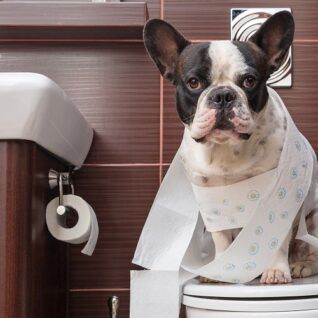Motives Why You Need to Never Get rid of Animal Waste Down the Toilet
Schedule EstimateThis post down the page on the subject of Should you flush animal waste down the toilet is relatively motivating. You should check it out.

When it concerns disposing of waste, particularly animal waste, lots of people usually resort to the hassle-free alternative of flushing it down the toilet. Nonetheless, this seemingly simple solution can have major effects for the environment and public health. In this short article, we'll check out why flushing pet waste down the commode is a negative concept and give alternative approaches for proper disposal.
Intro
Appropriate garbage disposal is crucial for maintaining ecological sustainability and public health. While it might seem safe to flush animal waste down the commode, it can cause various problems, both for the atmosphere and human well-being.
Dangers of flushing pet waste
Ecological influence
Purging animal waste presents hazardous bacteria and pathogens into rivers, which can negatively affect marine ecosystems. These microorganisms can pollute water sources and harm marine life, disrupting delicate ecological communities.
Public health concerns
Animal waste includes damaging germs such as E. coli and Salmonella, which can pose serious health dangers to humans. Purging animal waste down the commode can pollute water supplies, resulting in the spread of illness and infections.
Alternatives to flushing
Rather than purging pet waste down the toilet, there are a number of alternative disposal approaches that are extra eco-friendly and hygienic.
Composting
Composting animal waste is a green means to get rid of it. By composting, organic matter is broken down into nutrient-rich soil, which can be utilized to feed gardens and plants.
Garbage dump disposal
Throwing away animal waste in a land fill is an additional alternative. While not as eco-friendly as composting, it is a much safer alternative to flushing, as it prevents the contamination of water sources.
Family pet garbage disposal systems
There are specialized animal waste disposal systems offered that safely and hygienically dispose of pet waste. These systems typically utilize enzymes to break down waste and get rid of smells.
Actions to correct animal waste disposal
To guarantee proper disposal of pet waste, adhere to these steps:
Scooping and nabbing waste
Regularly scoop and bag pet waste making use of eco-friendly bags. This protects against waste from contaminating the environment.
Making use of designated waste bins
Dispose of bagged animal waste in assigned waste containers, such as garden compost bins or garbage dump bins. Prevent flushing it down the bathroom in any way costs.
Cleansing can and pet dog areas regularly
On a regular basis tidy can and animal locations to avoid the accumulation of waste and bacteria. Usage pet-safe cleansing products to keep health.
Advantages of proper disposal approaches
Embracing proper disposal approaches for pet waste supplies a number of advantages:
Decreased environmental pollution
Proper disposal techniques lower the danger of environmental pollution, safeguarding rivers and ecosystems from contamination
Lessened threat of water contamination.
By staying clear of flushing pet waste down the commode, the threat of water contamination is substantially lowered, safeguarding public health.
Improved sanitation and health
Appropriate disposal methods promote better cleanliness and health, producing a much safer atmosphere for both humans and animals.
Conclusion
Finally, flushing pet waste down the toilet is dangerous to the environment and public health. By taking on alternative disposal techniques and adhering to proper waste administration techniques, we can reduce the unfavorable effect of animal waste and add to a cleaner, much healthier world.
Why You Should Never Flush Cat Poop Down the Toilet
A rose by any other name might smell as sweet, but not all poop is created equal. Toilets, and our sewage systems, are designed for human excrement, not animal waste. It might seem like it couldn’t hurt to toss cat feces into the loo, but it’s not a good idea to flush cat poop in the toilet.
First and foremost, assuming your cat uses a litter box, any waste is going to have litter on it. And even the smallest amount of litter can wreak havoc on plumbing.
Over time, small amounts build up, filling up your septic system. Most litter sold today is clumping; it is made from a type of clay that hardens when it gets wet. Ever tried to scrape old clumps from the bottom of a litter box? You know just how cement-hard it can get!
Now imagine just a small clump of that stuck in your pipes. A simple de-clogger like Drano isn’t going to cut it. And that means it’s going to cost you big time to fix it.
For an amusing, graphic tale of what happens when you flush too much litter down the toilet all at once, take a few minutes to read Gene Weingarten’s 2017 Washington Post column “So that’s what happens when you flush cat litter down the toilet.”
Parasitic Contamination
Believe it or not, your healthy kitty may be harboring a nasty parasite. Only cats excrete Toxoplasma in their feces. Yet it rarely causes serious health issues in the cats that are infected. Most people will be fine too if infected. Only pregnant women and people with compromised immune systems are at risk. (If you’ve ever heard how women who are expecting are excused from litter cleaning duty, Toxoplasma is why.)
But other animals may have a problem if infected with the parasite. And human water treatment systems aren’t designed to handle it. As a result, the systems don’t remove the parasite before discharging wastewater into local waterways. Fish, shellfish, and other marine life — otters in particular — are susceptible to toxoplasma. If exposed, most will end up with brain damage and many will die.
Depending on the species of fish, they may end up on someone’s fish hook and, ultimately on someone’s dinner plate. If that someone has a chronic illness, they’re at risk.
Skip the Toilet Training
We know there are folks out there who like to toilet train their cats. And we give them props, it takes a lot of work. But thanks to the toxoplasma, it’s not a good idea.
Leave the toilet to the humans, and accept your future litter cleaning duty.

On a regular basis tidy can and animal locations to avoid the accumulation of waste and bacteria. Usage pet-safe cleansing products to keep health.
Advantages of proper disposal approaches
Embracing proper disposal approaches for pet waste supplies a number of advantages:
Decreased environmental pollution
Proper disposal techniques lower the danger of environmental pollution, safeguarding rivers and ecosystems from contamination
Lessened threat of water contamination.
By staying clear of flushing pet waste down the commode, the threat of water contamination is substantially lowered, safeguarding public health.
Improved sanitation and health
Appropriate disposal methods promote better cleanliness and health, producing a much safer atmosphere for both humans and animals.
Conclusion
Finally, flushing pet waste down the toilet is dangerous to the environment and public health. By taking on alternative disposal techniques and adhering to proper waste administration techniques, we can reduce the unfavorable effect of animal waste and add to a cleaner, much healthier world.
Why You Should Never Flush Cat Poop Down the Toilet
A rose by any other name might smell as sweet, but not all poop is created equal. Toilets, and our sewage systems, are designed for human excrement, not animal waste. It might seem like it couldn’t hurt to toss cat feces into the loo, but it’s not a good idea to flush cat poop in the toilet.
First and foremost, assuming your cat uses a litter box, any waste is going to have litter on it. And even the smallest amount of litter can wreak havoc on plumbing.
Over time, small amounts build up, filling up your septic system. Most litter sold today is clumping; it is made from a type of clay that hardens when it gets wet. Ever tried to scrape old clumps from the bottom of a litter box? You know just how cement-hard it can get!
Now imagine just a small clump of that stuck in your pipes. A simple de-clogger like Drano isn’t going to cut it. And that means it’s going to cost you big time to fix it.
For an amusing, graphic tale of what happens when you flush too much litter down the toilet all at once, take a few minutes to read Gene Weingarten’s 2017 Washington Post column “So that’s what happens when you flush cat litter down the toilet.”
Parasitic Contamination
Believe it or not, your healthy kitty may be harboring a nasty parasite. Only cats excrete Toxoplasma in their feces. Yet it rarely causes serious health issues in the cats that are infected. Most people will be fine too if infected. Only pregnant women and people with compromised immune systems are at risk. (If you’ve ever heard how women who are expecting are excused from litter cleaning duty, Toxoplasma is why.)
But other animals may have a problem if infected with the parasite. And human water treatment systems aren’t designed to handle it. As a result, the systems don’t remove the parasite before discharging wastewater into local waterways. Fish, shellfish, and other marine life — otters in particular — are susceptible to toxoplasma. If exposed, most will end up with brain damage and many will die.
Depending on the species of fish, they may end up on someone’s fish hook and, ultimately on someone’s dinner plate. If that someone has a chronic illness, they’re at risk.
Skip the Toilet Training
We know there are folks out there who like to toilet train their cats. And we give them props, it takes a lot of work. But thanks to the toxoplasma, it’s not a good idea.
Leave the toilet to the humans, and accept your future litter cleaning duty.

I have been very eager about Why you should never flush dog poop down the toilet and I am praying you enjoyed reading the blog post. So long as you liked our article please make sure you remember to share it. Thanks a lot for taking the time to read it.
Check This Out